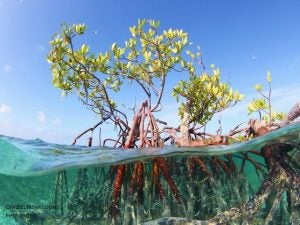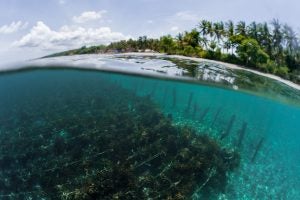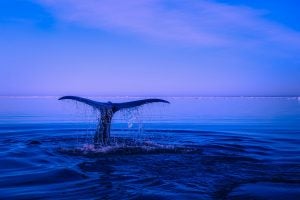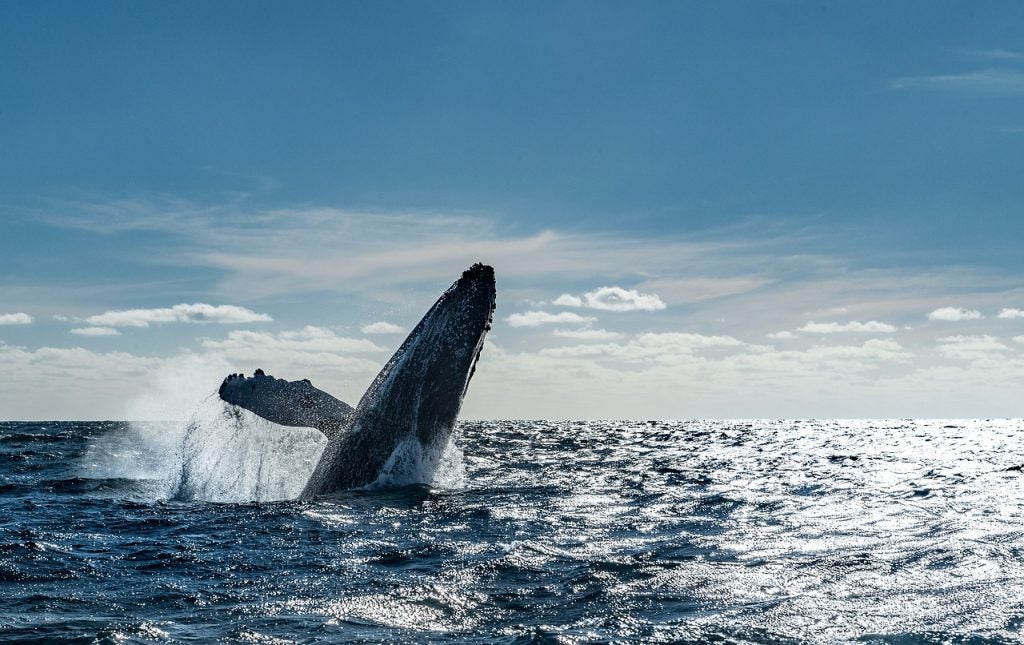As the biosphere continues to warm and the ocean acidifies, solving the global carbon problem becomes more critical each day. Keeping temperatures to survivable levels requires reducing emissions while at the same time working aggressively to absorb as much carbon dioxide as possible, using approaches that can nurture natural ecosystems and help vulnerable human communities flourish.
The ocean plays a major role in global carbon processing and storage, but it’s also among the least utilized. Here, we’ll explore the largely unappreciated but potentially powerful role of the ocean and coastal ecosystems to help solve the global climate problem through Blue Carbon.
Carbon: why the ocean?
Taken together, the ocean constitutes a massive carbon “sink” that significantly moderates the effects of climate change.
Taken together, the ocean constitutes a massive carbon “sink” that significantly moderates the effects of climate change. But how can society unlock the vast potential of the sea to help achieve planetary decarbonization? And how do we do that using approaches that help sustain natural coastal and marine ecosystems while also helping to nourish vulnerable human communities?
The power of nature: pathways to Blue Carbon
The three main buckets of Blue Carbon work that can be considered “natural climate solutions” include:
- coastal wetland stewardship, restoration and enhancement
- macroalgal restoration, enhancement and farming
- new approaches to offshore ocean ecosystem management that could radically improve its carbon prospects
 The role of coastal wetlands (mangrove swamps, seagrass beds and emergent salt and brackish marshes) is well-known. These systems are valued for their ability to store carbon in living biomass and in associated sediments. They are also critically important for the wide suite of ecological and socioeconomic co-benefits that their conservation can achieve: sustaining biodiversity, providing spawning and nursery habitats that sustain offshore fisheries, dampening coastal hazards, servicing tourism and more.
The role of coastal wetlands (mangrove swamps, seagrass beds and emergent salt and brackish marshes) is well-known. These systems are valued for their ability to store carbon in living biomass and in associated sediments. They are also critically important for the wide suite of ecological and socioeconomic co-benefits that their conservation can achieve: sustaining biodiversity, providing spawning and nursery habitats that sustain offshore fisheries, dampening coastal hazards, servicing tourism and more.
Yet there are some challenges with the coastal wetlands approach to Blue Carbon. Important questions must be answered about sustaining, reestablishing and expanding these benefits as climate change advances, including warming waters and sea level rise. There are also special vulnerabilities related to the fact that coastal wetlands are mostly monocultures; should a biological limit be reached or the wrong disease spread, carbon stored in these systems may not prove as well-stored as we all hope. Certainly, important work must occur at the system scale to facilitate up-gradient migration wherever possible, given the worldwide rise of the sea and other potential future changes to coastal areas.
The bottom line for now: ancillary benefits from coastal wetlands are so compelling that their conservation is a no-regrets strategy — even if long-term carbon benefits are harder to sustain.
 Beds of kelp and other macroalgae (aka seaweeds) serve similar ecological roles and have similar conservation benefits.
Beds of kelp and other macroalgae (aka seaweeds) serve similar ecological roles and have similar conservation benefits.
So, what makes kelp and macroalgae worth considering? Macroalgae has a high value for human use as well as fast growth and widespread suitability for culture. In many places, seaweeds are already farmed, producing human food, animal feeds, chemical feedstocks and other valuable commodities. There are also huge sections of the ocean suitable for expanded macroalgae culture, or simply for reforestation of the sea.
But there are unknowns and challenges in harnessing widespread seaweed production for carbon storage. In nature, much of that production is eaten by herbivores, which then respire the “fixed” carbon as CO2. Macroalgae carbon storage is also relatively “leaky:” under natural conditions, only a modest fraction of the carbon fixed in seaweed is delivered to settings where it could achieve long-term sequestration. Maybe the biggest challenge is documenting the extent of net sequestration from produced seaweeds at scale. That is, it remains unclear how to use seaweeds at large scale to achieve carbon sequestration without serious negative consequences. More research is certainly needed.
 Finally, the potential uses of the open ocean as a mainstream carbon fighting tool remain seductive, if still too new for practical application.
Finally, the potential uses of the open ocean as a mainstream carbon fighting tool remain seductive, if still too new for practical application.
When it comes to the open ocean, carbon sequestration is all about moving more carbon, deeper and faster. The main possibility for open ocean sequestration revolves around the sinking and redistribution of organic particles through waste processes and decomposition. These include: “marine snow,” where matter like exoskeletons, mucus and feces colonized by bacteria and fungi sink into the abyss; “whale falls” or “fish falls” of decomposing animals; and the “whale pump,” where great whales feed at ocean depths but defecate at shallow levels, redistributing carbon in the process. And it turns out that the most abundant and least recognized groups of fishes in the world ocean — living in the middle depths of the sea — serve a key role in moving carbon downwards. These fish come up to or near the surface at night before returning to the depths during the day.
Preventing the extinction of these key marine species — great whales and mesopelagic fishes — can help continue the valuable carbon redistribution they play essential roles in. Restoring whales, and perhaps large fish populations, could have an impact on how fast absorbed CO2 is converted into organic forms and then how fast that sinks into the deep sea, making marine species conservation an obvious first step.
Taken together, these pathways constitute literally and figuratively a carbon diamond in the rough: recognized for its prospective value by a few, but once properly shaped, seen as a brilliant and exciting resource.
What’s next?
All three of these Blue Carbon pathways constitute potential opportunities to add the world ocean to our climate-fighting arsenal, but they all require significant investment in science to hone existing knowledge and build an adaptive approach. I expect that in five- or ten-years’ time, we will look back wondering why it took us so long to start down these key pathways — and see Blue Carbon as the diamond in the rough it truly is.










